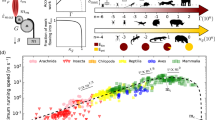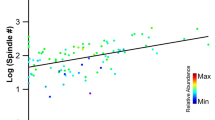Abstract
Animals have different muscle fibre types: slow fibres with a low maximum velocity of shortening ( Vmax) and fast fibres with a high Vmax. An advantage conferred by the use of different fibre types during locomotion1 has been proposed solely on the basis of their in vitro properties. Isolated muscle experiments show that force generation, mechanical power production and efficiency are all functions of V/Vmax, where V is the velocity of muscle shortening. But it is not known whether animals actually use the different fibres at shortening velocities that are optimal for mechanical power production and efficiency. Here we compare the V of muscle fibres during locomotion with their Vmax. This comparison shows that during slow locomotion, the slow fibres shorten at a velocity that gives peak mechanical power and efficiency and the fast fibres shorten at their optimal velocity when powering maximal movements. Our results also show that maximal movements are impossible without fast fibres because the slow ones cannot shorten rapidly enough.
This is a preview of subscription content, access via your institution
Access options
Subscribe to this journal
Receive 51 print issues and online access
$199.00 per year
only $3.90 per issue
Buy this article
- Purchase on Springer Link
- Instant access to full article PDF
Prices may be subject to local taxes which are calculated during checkout
Similar content being viewed by others
References
Goldspink, G. in Mechanics and Energetics of Animal Locomotion (eds Alexander, R. McN. & Goldspink, G.) 57–81 (Chapman and Hall, London, 1977).
Hill, A. V. Scient. Prog. Lond. 38, 209–230 (1950).
Hill, A. V. Proc. R. Soc. B 159, 319–324 (1964).
Kushermick, M. J. & Davies, R. E. Proc. R. Soc. B 174, 315–353 (1969).
Rome, L. C., Loughna, P. T. & Goldspink, G. Am. J. Physiol. 249, R272–R279 (1984).
Rome, L. C., Loughna, P. T. & Goldspink, G. Science 228, 194–196 (1985).
Julian, F. J., Rome, L. C., Stephenson, D. G. & Stirz, S. J. Physiol. 370, 181–199 (1986).
Altringham, J. D. & Johnston, I. A. J. Physiol. 333, 421–449 (1982).
Julian, F. J., Rome, L. C., Stephenson, D. G. & Striz, S. J. Physiol. 380, 257–273 (1986).
Zottoli, S. J. J. Exp. Biol. 66, 243–254 (1977).
Eaton, R. C., Lavender, W. A. & Wieland, C. M. J. Comp. Physiol. 144, 521–531 (1981).
Curtin, N. A. & Woledge, R. C. J. Physiol. (in the press).
Alexander, R. McN. J. Mar. Biol. Ass. 49, 263–289 (1969).
Author information
Authors and Affiliations
Rights and permissions
About this article
Cite this article
Rome, L., Funke, R., Alexander, R. et al. Why animals have different muscle fibre types. Nature 335, 824–827 (1988). https://doi.org/10.1038/335824a0
Received:
Accepted:
Issue Date:
DOI: https://doi.org/10.1038/335824a0
This article is cited by
-
Scaling the tail beat frequency and swimming speed in underwater undulatory swimming
Nature Communications (2023)
-
Muscle growth and plasticity in teleost fish: the significance of evolutionarily diverse sarcomeric proteins
Reviews in Fish Biology and Fisheries (2023)
-
Adaptations for extremely high muscular power output: why do muscles that operate at intermediate cycle frequencies generate the highest powers?
Journal of Muscle Research and Cell Motility (2023)
-
A Three-Dimensional W-Shaped Model of Musculo-Tendinous System for Kinematic Analysis of Undulatory Swimming
Iranian Journal of Science and Technology, Transactions of Mechanical Engineering (2023)
-
Modulus adaptive lubricating prototype inspired by instant muscle hardening mechanism of catfish skin
Nature Communications (2022)
Comments
By submitting a comment you agree to abide by our Terms and Community Guidelines. If you find something abusive or that does not comply with our terms or guidelines please flag it as inappropriate.



